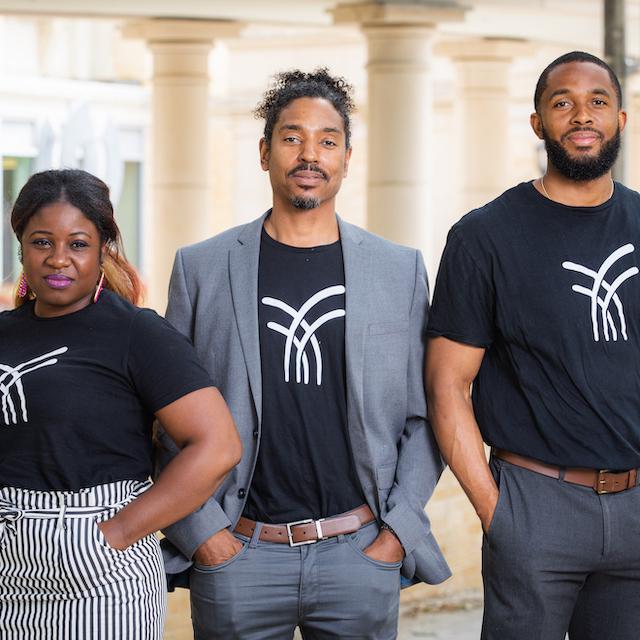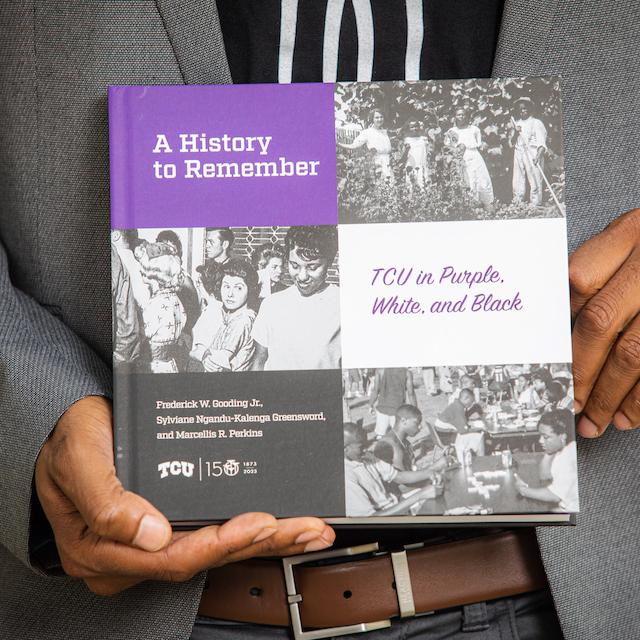
TCU’s 150th Told in Purple, White and Black
The Black story of TCU doesn’t begin in 1964 with desegregation, when the first few Black undergrads enrolled (if only for a short while). The story begins long before and alongside the Black American experience, which shaped our nation, state, city and, ultimately, our university.
 Frederick W. Gooding Jr, the Dr. Ronald E. Moore Honors Professor of Humanities –
with colleagues Sylviane Ngandu-Kalenga Greensword, postdoctoral fellow, and Marcellis
Perkins, doctoral candidate – are the authors of A History to Remember: TCU in Purple, White, and Black. Timed with TCU’s Sesquicentennial, their book represents a historical accounting
of the collective Black American experience as filtered through the more specific
lens of TCU, Gooding said.
Frederick W. Gooding Jr, the Dr. Ronald E. Moore Honors Professor of Humanities –
with colleagues Sylviane Ngandu-Kalenga Greensword, postdoctoral fellow, and Marcellis
Perkins, doctoral candidate – are the authors of A History to Remember: TCU in Purple, White, and Black. Timed with TCU’s Sesquicentennial, their book represents a historical accounting
of the collective Black American experience as filtered through the more specific
lens of TCU, Gooding said.
“It’s not that no one has ever written about the Black experience in relation to TCU, but nothing is as concentrated to this degree,” he said. “It’s the beginning of conversation, and we hope to add more voices onto it and that there will be different iterations.”
The 183-page hardback is told as a volume of essays, starting with TCU’s beginning as a small Reconstruction-era co-ed Christian school to a still-predominately white institution that is committed to reconciliation and racial healing. It shares the voices of how Black Americans experienced TCU over time in light of societal changes and policy changes at TCU.
With its 150th anniversary underway, it’s time – if not past time – to tell this story, Gooding said.
“This is a story that’s been 150 years in the making. When you look at recent events and the conversations those rekindled after the summer of 2020, TCU responded with the Race & Reconciliation Initiative to look at its relationship to slavery, racism and the Confederacy,” he noted. “Let’s not erase but embrace the past and look at this as an opportunity to show how we’re making progress.”
From Black workers like Charley and Kate Thorp who were employed by AddRan Male and Female College for more than 20 years, to everyday people who raised their voices and intervened, Blacks have had a fingerprint or footprint at TCU since the very beginning. But covering 150 years was challenging, so the authors divided the timeline into windows: Founding Years (1861-1891); Transition to Integration (1941-1971); and Recent but Related Histories (1998-2020).
“When we talk about telling this story, aside from the ‘firsts,’ like Allene Jones (who in 1962 broke the color barrier as a graduate student), it’s not as ‘black and white’ as it appears,” said Gooding.” For example, the five first Blacks who came to TCU as undergraduates in 1964-65 did not return.
“The first actual class of 1964 washed out,” Gooding said. “It was the transplanted Black teens who came to this campus in the years that followed that had to navigate true integration.”
They, and the Black faculty and staff, would become part of a legacy upon which others would stand.
Some of those voices of students, staff, faculty and alumni were literally recorded by the authors. They also visited local archives like the Granbury Depot and Hood County Courthouse to obtain official records and other documents. Still more stories were culled from sources like The Skiff, the yearbook, TCU Magazine and TCU Special Collections, plus TCU Board of Trustee and Student Government Association minutes.
The book also looks at the role of Black athletes, including Dr. James I. Cash, who in 1966 was the first Black student-athlete at TCU and the first Black basketball player in the Southwest Conference. Another chapter is dedicated to Black alumni and their achievements after leaving TCU and post-graduation contributions.
Gooding and his co-authors made sure they didn’t circumvent painful memories, like students’ use of blackface, Confederate flags on display, racial tensions and outright discrimination, even death threats.
“It’s the difficult times that we learn the most from,” Gooding said. “But some of the most significant policy changes at our institution occurred because students intervened. They took initiative because they cared, and, as a result, the university changed course.”
While there are challenges still ahead that are also documented in the book, Gooding is hopeful, thanks largely to the RRI.
“Now TCU is able to grow from those dark chapters,” Gooding said. “It’s never too late to walk the path of reconciliation.”
Of the TCU in Purple, White, and Black book itself, Gooding hopes that for those who pick it up, if they don’t read it from cover to cover, they’ll open to different sections and be surprised.
“Chances are that in nibbles and bites, they are going to uncover and discover something they didn’t know before,” he said. “Hopefully a book like this makes sense to students of present and is a reminder that they too are connected to this history.”
The book is available through TCU Press and in limited quantities at the TCU Campus Store.
Learn about other 150th commemorative books including Images and Stories of TCU's First 100 Years 1873-1973, Walking TCU: A Historic Perspective, A Remarkable Story to Tell and A Hope of Wisdom.
